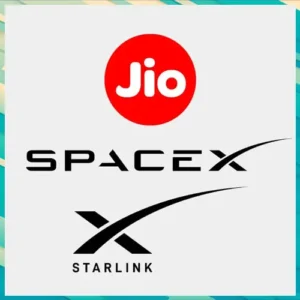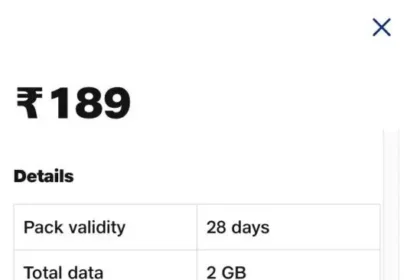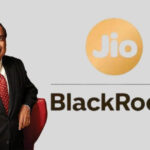Introduction
In a country of more than 1.4 billion, India’s digital revolution has transformed the way we live, learn, and work—but not equally. While cities have high-speed fibre optic networks and 5G connectivity, millions in rural and far-flung areas have slow or no internet at all. The digital divide restricts access to education, healthcare, online commerce, and even basic government services for nearly 40% of India’s population.
It’s a requirement for equitable growth in the world’s largest democracy. That’s where Reliance Jio’s path-breaking collaboration with SpaceX’s Starlink comes into the picture.
In early 2025, India’s largest telecom operator, Jio Platforms, partnered with SpaceX, led by Elon Musk, to launch Starlink’s satellite-based internet service in India.
Jio partnership will provide Starlink with hardware, installation, and support services, as well as assist with local compliance navigation, while Starlink contributes. It has an extensive satellite network to provide broadband-grade internet in even the most inaccessible parts of the nation, from Himalayan villages to desert hamlets.
This alliance is greater than a commercial agreement—it is a visionary move toward equality in the digital age, and may change India’s strategy on last-mile connectivity.
What Is Starlink?
Starlink is an internet service using satellites built by SpaceX, the space exploration company started by Elon Musk. Unlike conventional satellite systems that orbit high above Earth (about 35,000 km), Starlink is in low Earth orbit (LEO)—with heights ranging from 550 to 1,200 kilometres. This critical distinction offers enormous benefits.
How LEO Satellites Work
Conventional satellites are scarce, but LEOs utilise thousands of small satellites in a “constellation.” The satellites orbit the Earth at high speeds and nearby, with radio signals transmitted to ground terminals to enable internet connectivity. Since they are much closer to Earth, LEO satellites can offer faster internet with less lag.
Starlink’s Global Vision
The vision of Starlink is ambitious: to provide internet to the most remote parts of the globe, particularly underserved and far-flung areas. Starlink has already deployed more than 5,000 satellites as of 2025, reaching most continents and far-flung oceanic regions. It’s already operational in over 70 nations, aiding in the connectivity of areas hit by war, calamity, or geographical remoteness.
In India, this vision aligns perfectly with the country’s initiative towards “Digital India”—but Starlink’s presence there will be distinctive due to its local partnership with Jio and stringent government controls.
Speed, Latency & Performance
Starlink’s most significant advantage is performance:
For Indian rural users, this translates to streaming video without buffering, participating in online classes or doctor consultations in real-time, and making digital payments—all without waiting for fibre cables or cell towers.
The Jio–Starlink Deal
- In March 2025, Reliance Jio Platforms formally joined hands with SpaceX to launch Starlink satellite internet services in India.
- 2021–2023: Starlink’s first India registration hit a roadblock over licensing and data regulation challenges.
- Early 2024: SpaceX started probing for local partnerships to facilitate its entry into India.
- March 2025: Reliance Jio and SpaceX made a multi-phased commitment, signing with Starlink’s availability to Indian consumers.
- Mid–2025: The government gave conditional approval, subject to final security clearances and spectrum allocation.
- Late 2025 – Early 2026: Commercial launch anticipated, beginning with pilot projects in rural areas.
Who’s Bringing What to the Table
Starlink (SpaceX):
- LEO satellite constellation with the ability to provide swift, dependable internet nearly everywhere.
- Advanced ground station technology and user terminals (dish, router).
- B-backend infrastructure for the management of the network, performance, and software updates.
Jio Platforms:
- An extensive retail network and logistics setup in India for distribution and ground support.
- Mass-scale onboarding, service management, and low-cost pricing model expertise.
- Ability to manage local compliance, customer support, and installation support.
- Pre-existing connections with the Indian government and regulators, which would make it a good friend for SpaceX.
The union, together, merges Starlink’s advanced space technology with Jio’s reach, scale, and regulatory compliance—a combination that could accelerate rural internet penetration.
Government’s Role: Conditional Green Light
India’s telecom and space regulators have long emphasized the importance of local data storage, lawful interception, and national security in the operation of satellite internet. In June 2025, the Indian government granted conditional approval for Starlink’s commercial debut, subject to it:
- Sets up ground stations in India.
- Safely stores all user data locally (by India’s data localisation regulations).
- Resolves to share satellite telemetry with Indian authorities.
- Secures spectrum licenses and satellite landing rights.
These are usual but critical challenges that Starlink could not overcome single-handedly in previous tries. However, with Jio’s entry, these compliance issues are being overcome more quickly and efficiently.
Why India Needs Satellite Internet
India has been rapidly improving its digital infrastructure over the past few years. JioFiber and JioAirFiber services have provided high-speed internet to millions of households and businesses in urban and semi-urban India. Yet extending services to India’s far-flung and rural areas is a gigantic challenge—both logistically and financially.
Shortcomings of JioFiber & JioAirFiber in Remote Regions
- JioFiber, based on underground optical fibre cables, involves prohibitively expensive deployment costs and logistical challenges in hilly areas, forested regions, islands, or dispersed tribal hamlets.
- JioAirFiber, though wireless, still needs a reliable mobile signal and tower support, which is usually absent in remote villages.
- Consequence: millions of Indians are offline or have access to unreliable 2G/3G signals that are hardly sufficient for contemporary applications such as video conferencing or cloud-based software.
Urban vs. Rural: Bridging the Digital Inequality Gap
- More than 70% of India’s internet access is from urban and semi-urban regions, even though around 65% of Indians reside in rural areas.
- This inequality generates disparity in access to education, jobs, government services, and even financial solutions such as UPI and online banking.
- Without regular internet connection, rural India is unable to reap the benefits of the very schemes aimed at taking it forward—online education, e-health, or digital agriculture platforms.
- Starlink can provide high-speed internet to government schools in remote villages, providing for smart classrooms, digital libraries, and live virtual lectures even in the Himalayas or the Thar desert.
- Rural clinics and health centres may leverage satellite internet to communicate with urban-based specialists, offer online diagnosis, electronically manage health records, and react more effectively during emergencies.
- Farmers may obtain instant weather reports, view market prices, and utilise precision farming software or training videos—services frequently restricted by unstable networks.
Disaster Relief & Emergency Response
Where ordinary towers can be damaged or non-existent in flood, earthquake, or war-sensitive areas (such as borders), satellite internet can remain connected and aid emergency teams in coordinating rescue and supply operations in real time.
Put, satellite internet isn’t a backup option—it’s a lifeline for areas that conventional networks still fail to serve. With Jio and Starlink collaborating, such potential may become a reality for the millions of Indians in the future.
How Jio Partnership Could Change the Game
The partnership between Jio partnership and Starlink can revolutionise India’s connectivity—particularly in regions that have been bypassed by conventional telecom infrastructure. By combining Starlink’s satellite technology with Jio’s enormous local ecosystem, the partnership provides a model for rapid, scalable, and inclusive internet penetration throughout India.

Quick Deployment in Remote Locations
Whereas fibre cables or cell towers require months (or years) to be installed, Starlink’s satellite internet can be up and running in days. All one needs is a clear view of the sky, a dish terminal, and a power supply.
This entails:
- Border villages along Ladakh or Arunachal Pradesh can come online without having to wait for years of pipeline work.
- Islands, forested areas, and desert communities can get instant connectivity with little disruption.
- Temporary field hospitals and emergency response teams can establish communications in minutes, not weeks.
Seamless Integration with Jio’s Existing Network
Jio is not merely offering retail access—it’s making end-to-end ecosystem integration possible:
- Starlink connections may be offered bundled with Jio SIMs, JioAirFiber, or Jio Set-Top Boxes.
- Where fibre is not present, Starlink can act as a satellite backhaul—providing connectivity to remote towers and Wi-Fi hotspots to the broader internet.
- Jio can also provide customer support in local languages, making the service more convenient for rural users who are not conversant in English tech interfaces.
Replacing Old Rural Internet Solutions
Most rural institutions today use VSAT (Very Small Aperture Terminal) systems or DSL lines, which are:
- Slow (less than 5 Mbps),
- Unreliable, particularly in adverse weather,
- And expensive to maintain.
Starlink LEO technology can provide 10 times the speed at significantly lower latency, making it an alternative for schools, panchayats, rural banks, and small enterprises.
Aiding National Missions: Digital India & BharatNet
The government of India has been lagging in initiatives such as:
- Digital India – empowering the citizen with digital empowerment.
- BharatNet – connecting more than 6 lakh villages through broadband.
The Jio-Starlink partnership can:
- Enabled last-mile internet delivery in places where BharatNet fibre is yet to be completed.
- Service as an overlay to BharatNet, covering coverage gaps.
- Enable e-governance, digital inclusion, and online service delivery to rural communities.
This alliance doesn’t only provide an additional internet choice—it redraws the lines of what can be achieved in rural and remote connectivity, paving the way for India’s next major leap toward digital empowerment.
Challenges Ahead
Although the Jio–Starlink collaboration represents a significant leap in potential, achieving universal adoption across India will likely be a bumpy road ahead. From price to policy considerations, several challenges may slow or complicate the rollout—particularly for rural and low-income communities it plans to cater to.
- Premium Pricing of Starlink Kit and Monthly Subscription
The most significant challenge is pricing.
- Starlink hardware kit (dish + router): ₹25,000 to ₹35,000
- Monthly subscription: ₹3,000 to ₹7,000
Compared to:
- JioFiber begins at ₹500–₹1000/month.
- Mobile data plans start at ₹20–₹30/GB.
Even with Jio’s mass-market appeal, bringing Starlink to cost-effective levels for rural homes—where incomes are generally lower—will be the key challenge. Without subsidies, take-up might be restricted to institutions and high-income customers. Jio’s entry today addresses those concerns, conclusive regulatory clearances are still awaited, and any policy or geopolitical change could set back or disrupt the rollout—particularly in border or strategic areas.
Competitive Landscape
Indian satellite internet space is becoming hot, with other companies promoting their solutions:
- OneWeb (supported by Bharti Airtel): Already has ground station agreements in India and regulatory approval.
- Jio-SES Partnership: Before this Starlink deal, Jio was already partnering with Luxembourg-based SES to provide satellite broadband services in India.
- Amazon’s Project Kuiper: Will also enter the Indian market shortly.
These consumers might fuel price wars, accelerated innovation, or even fragmentation, depending on the dynamics of partnerships and spectrum policies.
Cultural Resistance & Digital Literacy Disparities
Even if Starlink is technically feasible, most rural consumers have fundamental impediments:
- Limited digital literacy for setting up or maintaining new hardware.
- Language barriers, since most satellite systems are initially developed for English-language markets.
- Mistrust or reluctance towards “foreign” technology or costly hardware.
- In certain regions, electricity supply continues to be unreliable, which will impact the performance of Starlink (as it needs an uninterrupted power supply and an unobstructed view of the sky).
It will be challenging to make access translate into genuine adoption without localised training, customer support centres, and information campaigns.
In other words, although the technology is stunning and the alliance is potent, success for Starlink in India will hinge on addressing these ground realities—rather than sending satellites into orbit.
The Future Outlook
The Jio–Starlink alliance is only the tip of the iceberg. Beyond rural internet, it promises entry to next-generation connectivity solutions that can revolutionise the way Indians connect to the internet—on the ground and even on the move.
- Direct-to-Cell: Mobile From the Sky?
Perhaps the most thrilling prospect is Direct-to-Cell satellite connectivity—mobile phones being directly connected to satellites without requiring towers or separate equipment. SpaceX has already started testing this technology in the United States with T-Mobile, and India may follow soon.
If adopted here, it could translate to:
- Network access from the jungles, mountains, and sea lanes.
- Emergency calling or messaging in disaster-hit or border regions where towers are absent.
- A revolutionary step up in pan-India mobile coverage, doing away with the notion of a “no signal” zone.
To this, India’s space and telecom ministries will have to clear fresh spectrum allocations and authorise the technology—but since Jio is already on board, the groundwork could be in place.
- Bundling With Jio Postpaid or Enterprise Plans
Jio is famous for its cost-friendly bundling—and it’s likely to extend this strategy to Starlink. Potential future bundles could include:
- Starlink + Jio SIM + OTT apps (such as JioCinema, Netflix, or Disney+ Hotstar).
- Starlink for Enterprises with priority bandwidth, static IPs, and cloud integrations.
- Educational institution, panchayat, or e-health project bundled plans with hardware financing.
India’s Space-Tech and Digital Aspirations
Apart from consumers, this tie-up is essential for India’s strategic aspirations:
- Encourages greater space and telecom public-private partnerships.
- Facilitates India’s Digital Public Infrastructure (DPI) vision by increasing reach.
- Sets India up for next-generation 6G satellite–terrestrial hybrid architectures.
- Places India as a high-impact market in the satellite internet global competition—inviting interest from Amazon (Project Kuiper), OneWeb, and more.
India’s ISRO has also expressed interest in collaborating with private satellite constellations, potentially leading to future interoperability and licensing.
The Jio–Starlink alliance is not merely a solution to rural broadband problems today—it’s a stepping stone towards a space-powered digital India tomorrow. With satellite-powered mobile connectivity, enterprise innovation, and national resilience on the horizon, this may unleash an entirely new wave of digital transformation.
Conclusion
The Jio partnership Starlink alliance is not merely a tech deal—it’s an emblem of possibility when ambition collides with innovation. With Jio’s extensive on-the-ground experience and local knowledge, India can now realistically hope to bridge its long-standing digital gap.
It’s about providing every Indian—no matter where they are—equal opportunity for digital empowerment.
With Starlink streaming from the heavens and Jio fueling the ground game, India is making an audacious leap towards a world where connectivity is a right, not a privilege.
FAQs
- What is Starlink, and how is it dissimilar from traditional broadband?
Starlink is SpaceX’s satellite internet service. It differs from conventional broadband as it employs low Earth orbit (LEO) satellites to send internet directly to user terminals rather than using physical towers and fibre to connect users to the internet.
- Where and how can I buy Starlink in India when it launches?
You can register and buy through:
- Authorised retailers and Jio stores
- Online through MyJio app and Jio.com
- Who will have access to Starlink first?
Early priority will be given to:
- Rural schools and clinics
- Government offices
- Small businesses in outlying regions
- Border and disaster areas
- Will Starlink function in bad weather or power failures?
Performance would decrease a little with heavy rain or storms, although LEO satellites are more robust than previous systems. A steady power supply is necessary for constant use.







